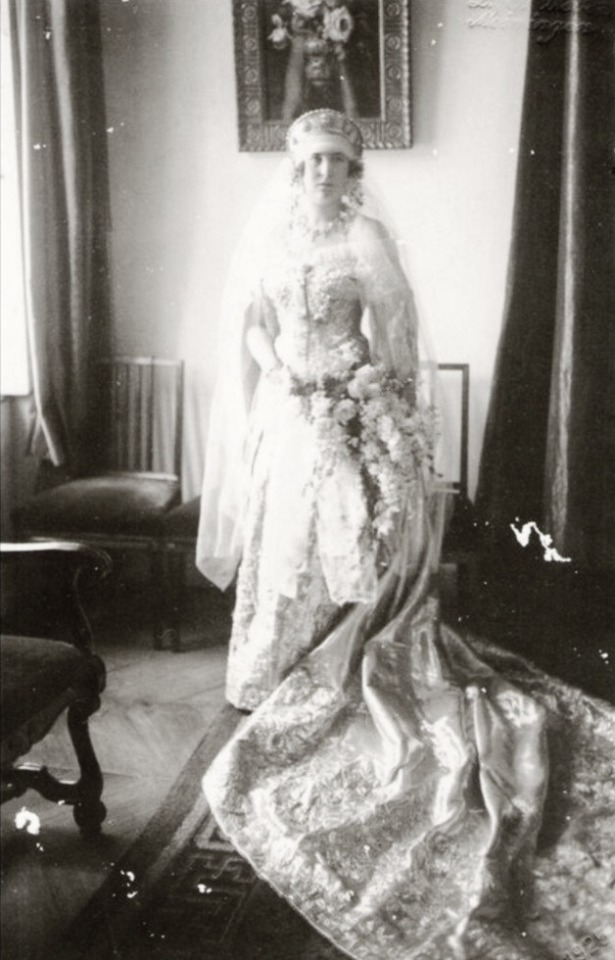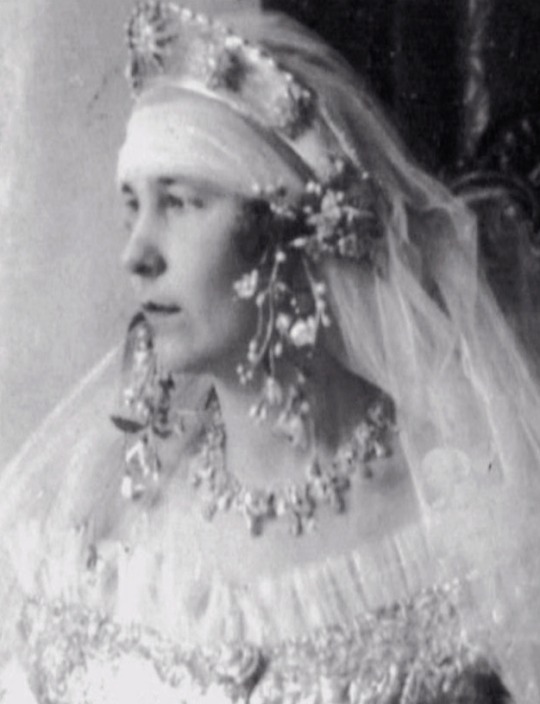#mathilde reuss
Explore tagged Tumblr posts
Text

Mathilde Reuß
Papageien auf Ginkgobaum
Farbholzschnitt/Papier 24 x 25,5 cm
signiert Mathilde Reuß München, monogrammiert MR
monogrammiert im Druck MR
beschriftet "Originalholzschnitt Handdruck"
0 notes
Text
Royal Wedding on 25 November 1925 in Langenburg.
Prince Karl of Leiningen (27) and Grand Duchess Maria Kirillovna of Russia (18).

The bridegroom was the third child and second born son of Emich, 5th Prince of Leiningen and his wife Princess Feodora of Hohenlohe-Langenburg. His eldest brother, Emich Ernst, Hereditary Prince of Leiningen, died at the age of twenty-one in 1918. So, Prince Karl became his father's heir.
Both of his parents were related to Queen Victoria.
The bride was the eldest child of Grand Duke Kirill Vladimirovich and his wife Princess Victoria Melita of Saxe-Coburg and Gotha. Her mother was previously married to Ernest Louis, Grand Duke of Hesse and by Rhine and had a child by her first marriage, Princess Elisabeth of Hesse and by Rhine who sadly died of virulent tiphoid fever in 1903.
The dashing bride wearing her maternal grandmother's wedding dress.




The wedding ceremony

The bride and her first cousin Princess Irma of Hohenlohe-Langenburg.

The wedding guests

Back row: Prince Hermann of Leiningen, Princess Marie Melita of Schleswig-Holstein, Princess Elizabeth of Greece and Denmark, Grand Duke Dmitri Pavlovich, Princess Marina of Greece and Denmark, Prince Gottfried of Hohenlohe-Langenburg, unknown man, Infanta Beatrice Duchess of Galliera, unknown man and Infante Alfonso Duke of Galliera.
Middle row: Duke Charles Edward of Saxe-Coburg and Gotha, unknown woman, Prince Ernst II of Hohenlohe-Langenburg, Princess Consort Alexandra of Hohenlohe-Langenburg, Heinrich XLV, Hereditary Prince Reuss Younger Line, Prince Hesso of Leiningen, Emich 5th Prince of Leiningen, Duchess Marie Antoinette of Mecklenburg-Schwerin, Princess Viktoria Countess of Solms-Rödelheim and Assenheim and unknown people.
Front row: Princess Caroline Mathilde of Saxe-Coburg and Gotha, Tsar Ferdinand I of Bulgaria, Princess Alexandra of Hohenlohe-Langenburg, Grand Duchess Victoria Feodorovna, Grand Duke Vladimir Kirillovich, Grand Duchess Kira Kirillovna, Princess Irma of Hohenlohe-Langenburg, Princess Feodora of Leiningen, Prince Friedrich Josias of Saxe-Coburg and Gotha, Princess Nicholas of Greece and Denmark, Duchess Victoria Adelaide of Saxe-Coburg and Gotha, Princess Sibylla of Saxe-Coburg and Gotha, Grand Duke Kirill Vladimirovich and Grand Duchess Elisabeth of Oldenburg.
Some royal guests

Back row: Princess Alexandra of Hohenlohe-Langenburg, Princess Irma of Hohenlohe-Langenburg, Grand Duchess Kira Kirillovna and Princess Sibylla of Saxe-Coburg and Gotha.
Front row: Grand Duke Vladimir Kirillovich and Prince Friedrich Josias of Saxe-Coburg and Gotha.
#karl 6th prince of leiningen#grand duchess maria kirillovna#grand duchess maria kirillovna of russia#grand duke kirill vladimirovich#grand duchess victoria feodorovna#emich 5th prince of leiningen#princess feodora of leiningen#duke charles edward of saxe-coburg and gotha#duchess victoria adelaide of saxe-coburg and gotha#princess nicholas of greece and denmark#infanta beatrice duchess of galliera#infante alfonso duke of galliera#prince ernst ii of hohenlohe-langenburg#princess consort alexandra of hohenlohe-langenburg#tsar ferdinand i of bulgaria#grand duke dmitri pavlovich#duchess marie melita of schleswig-holstein#prince hesso of leiningen#prince hermann of leiningen#princess viktoria of leiningen#grand duchess kira kirillovna#grand duke vladimir kirillovich#princess sibylla of saxe-coburg and gotha#princess caroline mathilde of saxe-coburg and gotha#prince friedrich josias of saxe-coburg and gotha#princess alexandra of hohenlohe-langenburg#prince gottfried of hohenlohe-langenburg#princess irma of hohenlohe-langenburg#royal weddings#grand duchess elisabeth alexandrine of oldenburg
76 notes
·
View notes
Photo










House of Reuß & of Hohenzollern: Princess Hermine Reuß aka Princess Hermine Reuß Older Line or Princess Hermine Reuß of Greiz
Hermine was born as the fourth daughter and fifth child of Heinrich XXII, Prince Reuss of Greiz and his wife Princess Ida Mathilde Adelheid of Schaumburg-Lippe. Among her siblings were her brother Heinrich XXIV, Prince Reuss of Greiz, and her sister Caroline, The Grand Duchess of of Saxe-Weimar-Eisenach. After her mother’s death in 1891, when Hermine was only three years old, she was raised at the court of Princess Louise of Prussia, The Grand Duchess of Baden - an aunt of her second husband to be.
At the age of 19, she married her first husband Prince Johann Georg of Schoenaich-Carolath with whom she had five children. Johann Georg died of tubercolsis in 1920.
Hermine had admired The German Emperor since her childhood and sent an Easter greeting, written by her son George, to him in 1922. Wilhelm II had been widowed for about a year then after the death of his first wife Empress Augusta Victoria. Wilhelm was greatful for the letter and answered it personally, establishing an active exchange of letters between him and Hermine. In June of the same year, he invited mother and son to his exile in the Netherlands. During there visit he asked her to marry him and set the date for the wedding still in the same year.
But although having a lot in common, the age difference of 28 years and by that the different upbringing caused some tensions. While The Emperor’s first wife was rather submissive, Hermine was not. She thought for herself and acted upon a her thoughts, something Wilhelm was not used to. However, the marriage is genereally seen as a happy one.
In their exile, they continued their life as if the German monarchy had never ended. Hermine, although not entitled to, titled herself as German Empress and Queen of Prussia, when after 1918 she was only entitled to the surname of Princess of Prussia. Hermine founded a charity organisation called the Herminen-Hilfswerk to help the less fortunate in the Weimar Republic.
But what also should not be forgotten that she was a hypocrate. Like her husband, she hoped for the restauration of the monarchy and put her trust in the Nazis to reestablish it. Further, she was, like her husband too, an anti-Semite. However, she adored the Jewish author Jakob Wassermann and even praised him after his works were banned by the Nazis.
in 1927, Hermine published her memoires up to that point. It is available in English and is called An Empress in Exile - My Days in Doorn while the German title is Der Kaiser und ich - Mein Leben mit Kaiser Wilhelm II. im Exil [The Emperor and I - My life with Emperor Wilhelm II. in exile].
After Wilhelm’s death in 1941, Hermine returned to the residence of her first husband in Silesia. After her oldest son died on the frontlines in 1943, Hermine fled West from the Red Army in 1945. Her youngest sister Ida, The Princess of Stolberg-Rossla, took her in. After the war, the occupancy of the region went from the Americans to the Russians what Hermine did not want to believe until she was taken to Berlin by the Red Army. After a while they took her to Frankfurt Oder where she lived in a small apartment until her death in 1947 due to sudden heart failured.
Hermine’s resting place was supposed to be by her second husband’s side in the Netherlands but due to burreaucratic issues, she was buried at the Antiktempel in the park of Sanssouci castle, next to her predecessor Augusta Victoria of Schleswig-Holstein.
// Janet McTeer as Princess Hermine Reuss of Greiz in The Exception (2016)
#period drama#perioddramaedit#historyedit#The Exception#20th century#European history#1900s#German Empress Hermine#German Empresses#Women of German Principalities#Royal Women of Prussia#Princess Hermine Reuß of Greiz#House of Hohenzollern#House of Reuß
94 notes
·
View notes